My Top 6 Apps for Flipping Used Clothes and Home Goods
For more than a year now, I've been trying to sell various items from my collection to free up some space in my closet—while also making enough money to buy new things.
I have encountered highs, lows, and many resale apps, some of which are better than others. In addition to making me a little extra money, this endeavor has really helped me reduce my clutter, too: A lot of the popular decluttering techniques ask you to sort your items into three categories—keep, throw, and donate—but by adding the fourth category of things to sell, I've cleared major space in my closet. What's more, I do my best to use my "balance" in each app to buy any new items I want or need, helping me stick to my own version of the " one in, one out " decluttering method.
After all these months and dozens of trips to the post office, here's what I've learned about buying and selling online and which apps I recommend most.
A few notes on reselling clothing online
There are sellers on these apps who do this in a hardcore way, sourcing cool, rare, or expensive items and turning them for a profit. They treat this like a job and, in some cases, it is their job. You don’t have to be like that. Don’t worry about the profiles that feature professional-grade photos and hundreds of listings, because someone out there wants the thing you’re selling and will find it by searching for it—it won’t really matter if you’re displaying the item on a mannequin in studio lighting as long as it’s the right size and price for the buyer.
Below are my suggestions to help you begin.
- Only include items that you wouldn't mind selling if someone were interested in buying them. That might seem straightforward, yet it’s occurred to me too: I sometimes become overly enthusiastic, add an item I still want for myself, and end up feeling downcast when it sells faster than anticipated. To protect against this, I’ve started pricing items I’m fond of more highly than their actual worth. Potential purchasers often find these listings appealing and occasionally make offers I'm willing to entertain. Should anyone purchase them at my asking price, then perhaps it was fate—plus, the additional funds help ease the sorrow of parting with the object.
- On the other hand, do not include something if you really I want it removed from the house. You can't predict how quickly an item will sell, even if you set a lower price and advertise it daily on various platforms. If waiting for a sale slows down your decluttering process, think about taking the item to a physical consignment store if it holds significant value, or simply donate it instead.
- I continue using my items even when they're posted on my app, but proceed with caution if you decide to follow suit. . If something happens to a bag, like it gets a scuff or a stain, it reduces its value and you’ll have to update the listing at the very least. Don’t try to trick people by showcasing something in perfect condition, then sending it to them in worse shape. They can send it back and this can have an impact on your seller rating.
- Take a lot of pictures You don’t require elaborate lighting or a background, but I make an effort to display my items on a nice rug and ensure nothing else distracts from the scene. Capture images from various perspectives, detailed shots highlighting any wear or damages, and a photo of the date mark or serial number if it’s a premium item. Include tags, distinctive elements, and fine points as well. (Should you skip these steps initially, expect future inquiries from prospective buyers seeking this information.)
- Stay receptive to proposals and address questions promptly. Most of the time, you won't receive the exact price you're asking for, based on what I've encountered; however, considering fair deals or agreeing to reduce the cost might assist you in clearing out your space and getting funds deposited into your account.
- Always look up the product you're trying to sell to check out the prices others are asking for similar items. If yours has similar quality, think about pricing it slightly lower than your competitors to sell it more quickly.
- If you post the same item across several platforms, keep track of your actions. A couple of weeks back, I offloaded a wristlet which I initially undersold on an app shortly after putting up its correct price on another platform. This resulted in me missing out on better earnings! Additionally, once an item gets sold on one app, you must promptly delist it from all other platforms. If not, someone might still purchase it elsewhere, leading to canceled orders and potentially damaging your seller reputation.
- Lastly, and maybe most crucially, watch out for scams. This guideline is particularly relevant when you’re purchasing rather than selling items. However, as a standard practice, always avoid communicating outside of the app and under no circumstances should you carry out transactions elsewhere. The platforms mentioned are known for their reliability and good management. If someone claims there’s an issue with the payment process, they are likely not telling the truth. Each platform highlighted offers excellent customer support and can assist you if you receive a fake product or deal with a dishonest buyer regarding the state of your sold item; however, these services will only intervene if all interactions occur within the app itself.
The initial app required is Vendoo.
Before diving into my list of favorite apps for purchasing and reselling items, I first want to commend one app that has significantly simplified my experience with all of them: Vendoo Basically, this is an application designed to help you manage multiple selling platforms simultaneously. It allows you to make lists of items you wish to sell and upload these listings across various online marketplaces such as Poshmark, Vestiaire Collective, Depop, Mercari, among others. This tool also lets you adjust pricing, monitor sales progress, and maintain better organization when your objective is to liquidate your belongings quickly and efficiently.
Offering your products on various platforms is beneficial since, although many customers browse several applications, each platform also boasts a fairly loyal user base that remains faithful to it. only Utilizes just one particular marketplace. Through cross-listing, you boost your odds of attracting a potential buyer who might come across your item.
An additional useful application is PrimeLister , but specifically if you’re selling on Poshmark. This tool automates all those small, time-consuming tasks that can enhance your sales performance—like sharing your listings with your followers' landing pages and homepages—and also provides an option for bulk actions such as adjusting prices or issuing discounts to potential buyers who have shown interest.
Both Vendoo and PrimeLister come with a price tag of around $30 each month, varying based on the features you require; however, from personal experience, they are worthwhile investments for increasing your sales and simplifying the process.
Top applications for selling clothing and accessories
Even though I only really got into selling about a year ago, I've been buying on these platforms for many, many years and made the sporadic sale here and there back in the day, too. I recommend Poshmark, Vestiaire Collective, TheRealReal, and Depop. To me, these four have the best interfaces and are easiest to use for buying and selling. Let’s go over their details.
Poshmark: Ideal for selling just about everything
When you sell on Poshmark As long as your sales exceed $15, you retain 80% of the revenue. If an item sells below $15, the platform charges a flat fee of $2.95. When using this application, buyers have the option to make counteroffers at a price lower than your listed one; however, accepting or rejecting these offers remains entirely up to you.
Passing up an opportunity lets you propose a different deal, giving room for some negotiation. However, the application clearly informs you about the exact amount you'll receive if you decide to sell at a specific price point. Buyers have the option to express interest in items by liking them, which enables sellers to extend exclusive discounts to everyone who has shown interest in their listing simultaneously. It’s straightforward to reduce prices as well, plus you can distribute your listings within themed groups known as ‘parties’ that align with your product type. As an example, Poshmark frequently organizes events centered around high-end handbags, setting up dedicated pages where interested shoppers congregate; during these occasions, I direct my bag-related postings towards those gatherings.
Creating a listing is very easy if you're doing it in-app, not using a third-party service like Vendoo. Upload your photos, fill out a form that includes simple details like size, brand, original price, and asking price, and you're good to go.
The drawback of using Poshmark lies in the necessity for high engagement.Offers become invalid after one day, sharing listings is restricted to ongoing parties, and users anticipate prompt replies to their comments.
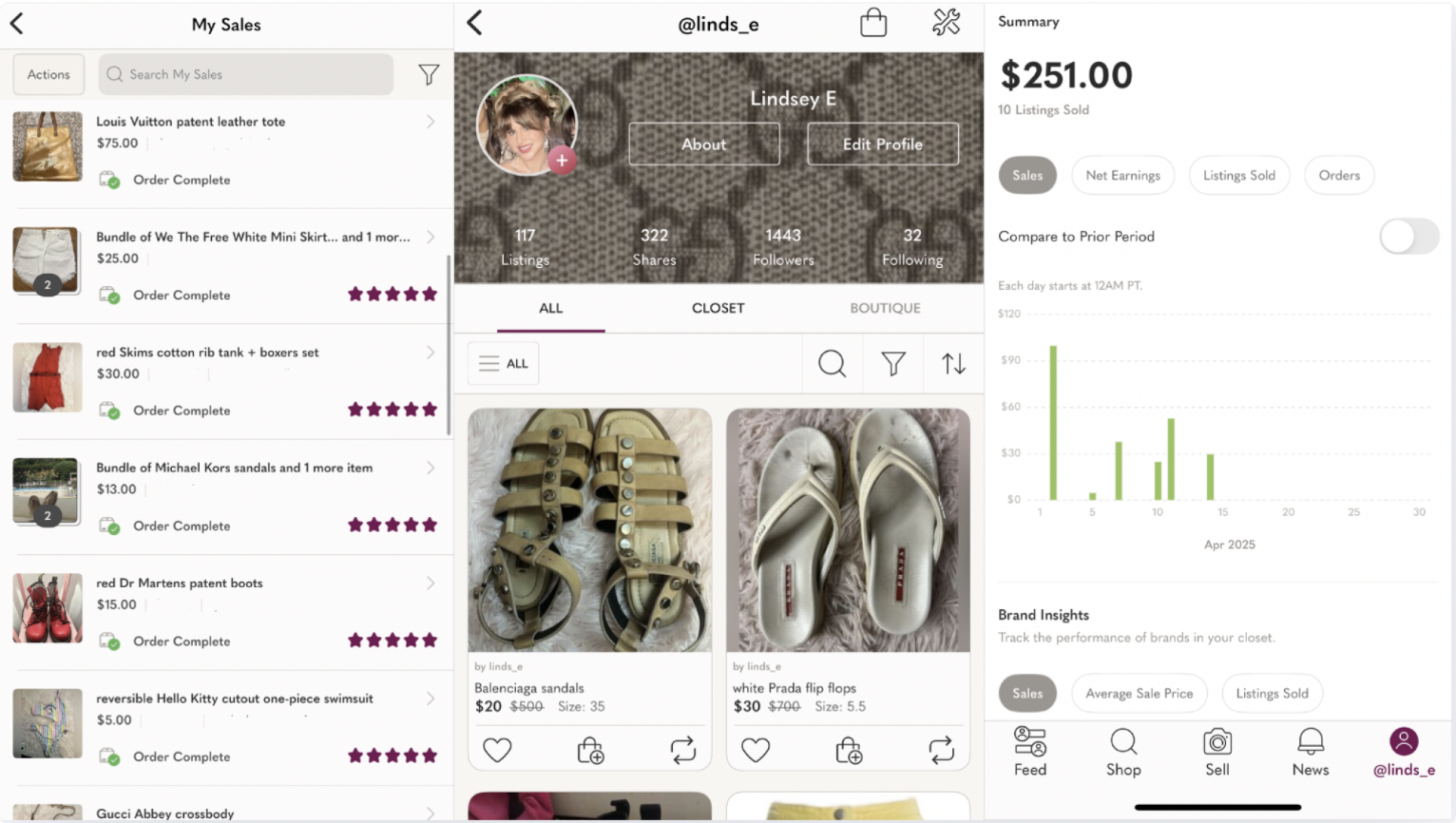
As I mentioned, you can include just about anything on this platform. It could be something like a Louis Vuitton handbag or perhaps a pair of Nike shirts. Others choose to list items such as home goods and handmade crafts. Personally, I have purchased several Diptyque candles and also sold a Yankees bobblehead that I picked up unintentionally during my visit to the Bronx. So, if what you're looking for is an application through which you can sell things, everything , not just a certain kind of clothing, it should be Poshmark.
In my experience, selling higher-end items on Poshmark is hit or miss. Yes, I've done it, but people on there are shopping for all kinds of things. I mostly buy baseball jerseys there and save my own luxury resale browsing for other apps. Poshmark doesn't authenticate designer goods the way other dedicated luxury apps do, so buyers are less confident and more likely to lowball you to make up for their lack of faith in your wares. If you have mid-tier stuff, like Lululemon, Uggs, or Skims, Poshmark is going to be especially handy for you.
All that said, Poshmark is by far my most-used resale app and I'd say I conduct over 90% of my business there. The interface is easy to navigate, the variety of listings and diverse user base lend themselves to a surprisingly high amount of sales on even the most random things, and selling is really easy. When I make a sale, Poshmark generates a QR code that I simply have to show to the people at the post office. The shipping fee is paid by the customer and includes a priority box or envelope. I don't have to print a label, buy a box, or do anything but show up at the post office. A day or two after the buyer gets the item, the money appears in my balance. Crucially, Poshmark allows you to use your sales balance to purchase things on the app, which I really love, but you can also very easily transfer it out into your bank account. Read my full Poshmark review here .
Vestiaire Collective: Best for higher-end items to maximize profits
Vestiaire Collective This platform caters primarily to premium products, often referring to luxury items, though it also includes many other high-quality goods such as those from Gymshark. Its standout feature is its rigorous authentication procedure. Typically, when you list an item here, it gets directly sent to Verified Collegiate (VC), where their staff verifies the product before shipping it off to the purchaser. This added layer of protection is particularly valuable for expensive items. Additionally, VC charges relatively modest seller fees: they take 10% per transaction along with a 3% payment processing charge. Notably, your initial listing won’t incur these costs provided it doesn’t exceed $2,000.
VC often runs specials, too, where where you'll pay no seller’s fees on certain brands, for example. Like Poshmark, buyers can send offers, but here, you have two days to accept, decline, or counter them, rather than one. One difference that can throw a bit of a learning curveball is that once you accept an offer, the buyer has to make the purchase. On Poshmark, a buyer who sends an offer agrees that if you accept it, their balance or card is charged. On VC, just because you accept the low price does not mean you've made the sale. The buyer then has two more days to decide if they want to go through with it. Selling on VC, in my experience, is a much slower process than other apps, especially because of the extra time required for in-person authentication.
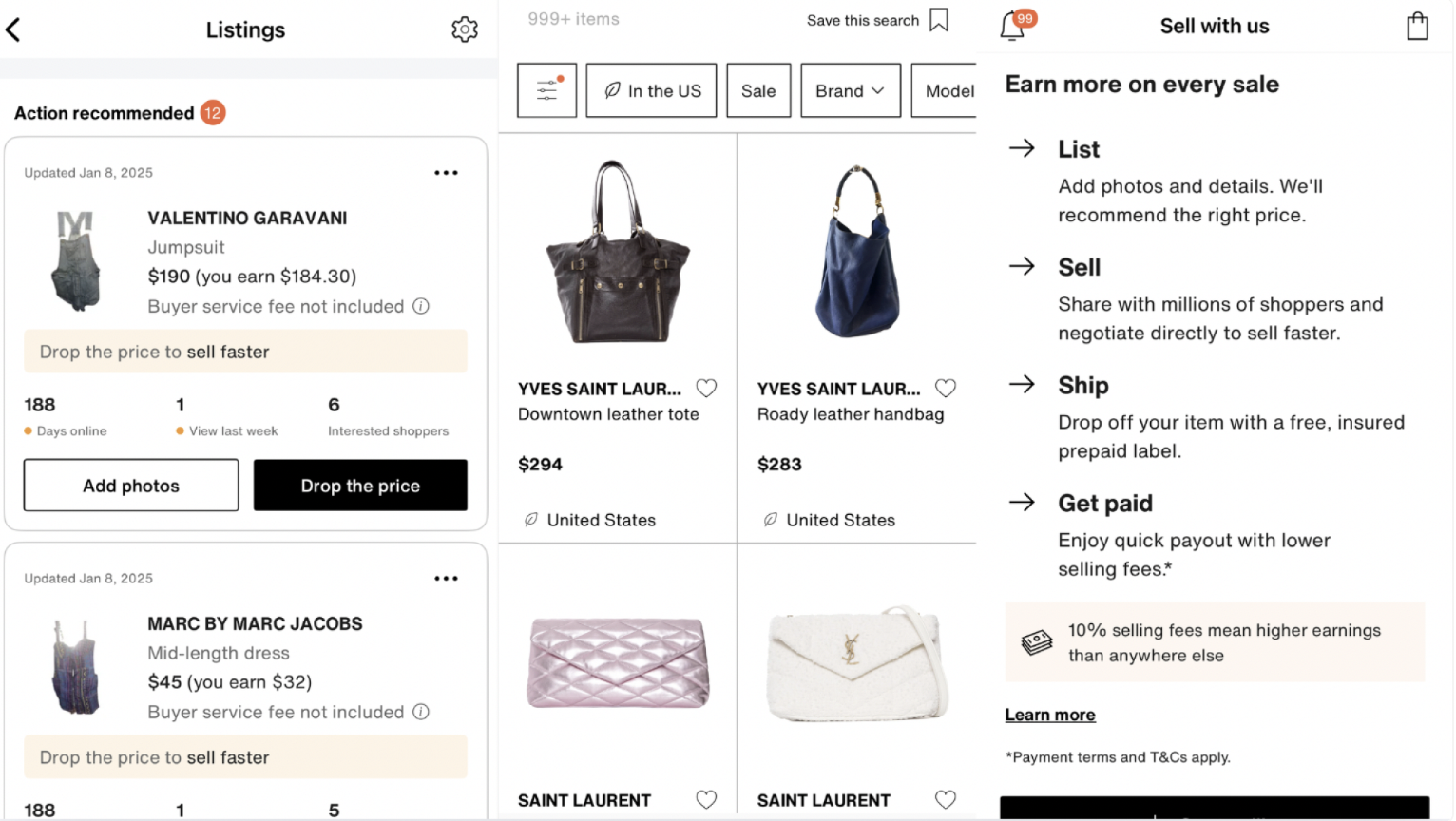
Overall, I love buying on here because I know I'm always getting high-quality goods, but the slow pace of sales stops me from selling on VC too often. When you make a VC sale, you don't get a handy QR code to ship the item. Rather, you have to print the label, buy a box or envelope, and ship it yourself. It takes a while for the money to get to you, given that the item has to go to VC for authentication before being sent out to the buyer. And when you do get that money, it goes into your Venmo account, not a balance that you can use to make new purchases.
It's worth noting that VC is the most global app on my list. People around the world buy and sell on here, which is awesome because it really broadens the market from which you can purchase and the population to which you can sell, but not-so-awesome because global shipping certainly takes a while. If you buy, don't expect your item to come in quickly—and if you sell, don't expect your money to come in quickly.
Shoppers on this platform tend to invest in high-quality products, hence they rarely offer lowball prices. Items that might struggle to sell on average platforms receive significant interest here. When selling via VC, ensure you accurately gauge the dimensions of your items, capture detailed photographs showcasing clear branding labels, and specify the materials used. Be prepared for potential delays as photo approvals can sometimes take up to two or three business days from an administrator. This isn’t a quick-cash application; however, it offers useful benefits such as suggesting sale prices based on recent sales data for comparable goods, eliminating the need for speculation. Despite requiring additional efforts like precise measurements and comprehensive photography, these tools streamline the process somewhat. Additionally, compared to rival apps, VCs takes a smaller share of profits which means greater earnings for sellers who commit time and effort. Check out my complete Vestiaire Collective review here. .
TheRealReal: Best for fancier stuff you just want out of your house
TheRealReal is only for designer, luxury items, and it operates more like a consignment store than direct selling. How much you actually make depends on your “loyalty tier” at the time of sale, so if you’re just starting out, you get 55% commission on anything sold for more than $195. If you earn $1,500 in annual net sales, you move up to a new tier and earn more. You can also just fork your goods over to TRR in exchange for site credit and let them sell as they will. I won’t lie: It’s a little confusing, so only go with this one if you have really expensive items to sell that require authentication and can still bring in a hefty chunk of cash, even with fees.
I use this app almost exclusively as a buyer, not a seller. Since TRR is in charge of the prices, a lot of really nice things inevitably go on a deep discount if they don't get sold quickly. If you want a quality piece that you can wear for a little and then resell, try looking here.
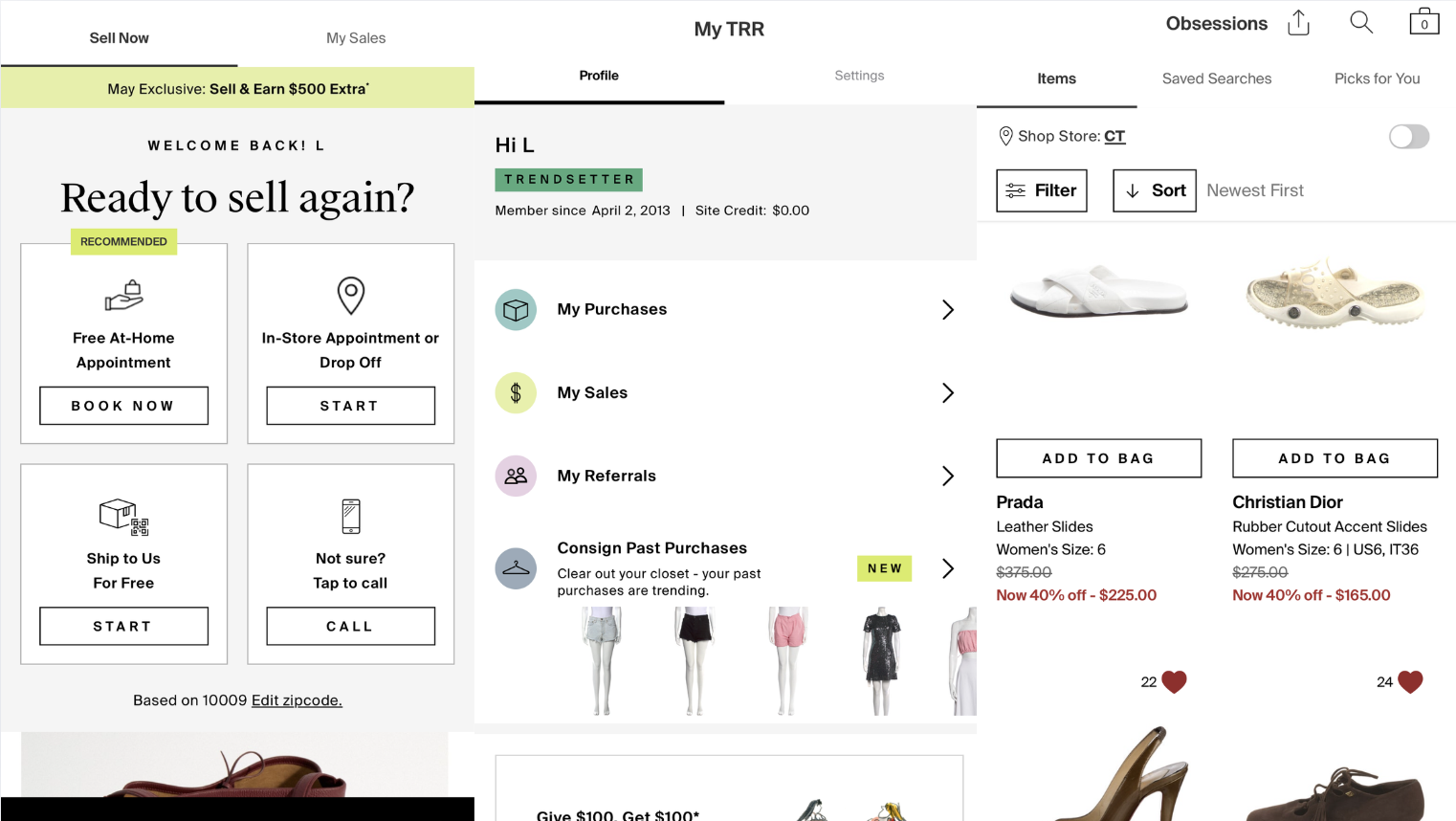
Depop: Ideal for offloading everything you own, ranging from mainstream purchases to higher-end items.
Depop is another site where you can sell anything . It can be fancy, it can be basic, it can be handmade—you can sell whatever. You don’t pay a listing fee, but you pay a 10% fee for everything you sell. That’s it. It’s super straightforward, and Depop helps you fill out the listing by populating suggestions based on your pictures and text inputs. This speeds up the process so you’re not spending five minutes on every listing, pulling brand names and sizes from drop-down menus. You can offer likers discounts and, like Poshmark and VC, field offers from potential buyers.
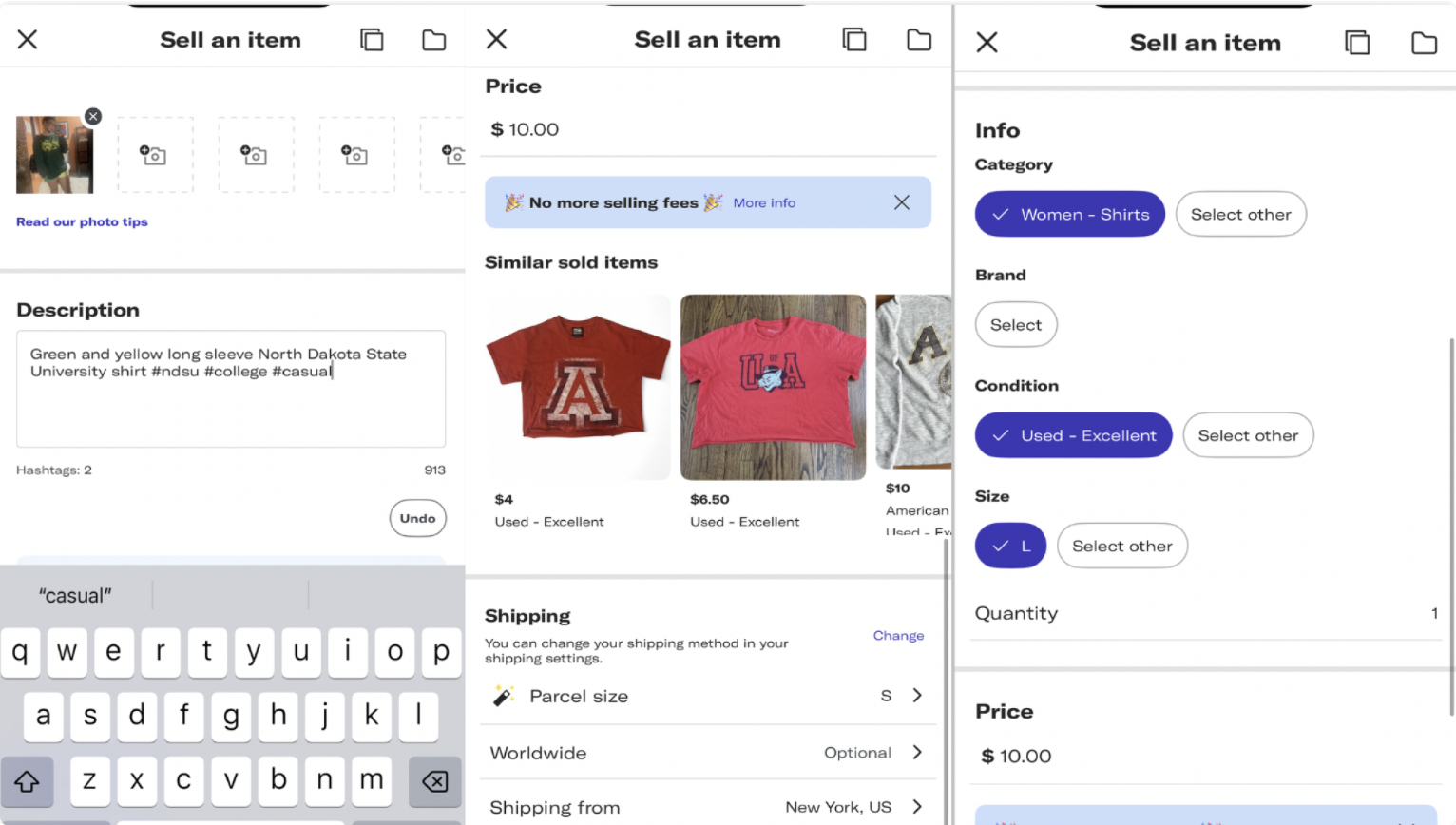
I've had success with Depop as a seller and a buyer, but it's definitely a crowded marketplace. I think of it more like a thrift store than anything. You can find fancy things, yes, but they're not authenticated and I've seen pages and pages of very obvious fakes (and, likely, less obvious fakes I didn't bother investigating), so beware. (As a side note, if you ever need help determining if a listed luxury product is authentic, you can reach out to me. This is a fun hobby I genuinely enjoy.)
Additionally, essential items likeForever 21 tops stand out. You might believe that the quick-turnaround, shopping-mall acquired shirts cluttering your wardrobe aren’t worthy of being sold. However, you’d be quite astonished. There’s someone somewhere who could desire these clothes, hence list them on Depop prior to either donating or discarding them. Establish a strict timeframe for yourself nonetheless. Should they remain unsold after about two weeks, dispose of them through an alternative method. Selling is great; however, it shouldn’t hinder your ability to successfully reduce excess possessions. Read my full Depop review here .
Best for set-it-and-forget it sales: Mercari
I am very new to Mercari , as it's the only app on this list I downloaded just to review and had never used before. That said, I liked what I saw! The process of listing on Mercari is especially simple, so this is a solid entry point if you're new to reselling and want to start with a more manageable experience. Tapping Sell at the bottom of the home screen brings you to a listing creation page that is notably pared down when compared to the other apps on this list. You add your photos, a title, a longer description, up to seven hashtags, a category, a brand, and a condition indicator. You have the opportunity to offer free shipping (which means you pay for it) or make the buyer pay the cost. Then, you set your listing price. That's it.
Remarkably, Mercari will even handle your discounting for you, which is something you have to do manually on the other apps or else recruit a third-party service like PoshLister to manage for you. When you finish creating a listing, just toggle on "Smart Pricing," set a minimum you'd be willing to accept for the product, and do nothing else. Over time, if it doesn't sell, Mercari will incrementally lower the price until it hits that minimum you set. Of all the apps here, this one is the most hands-off from beginning to end.
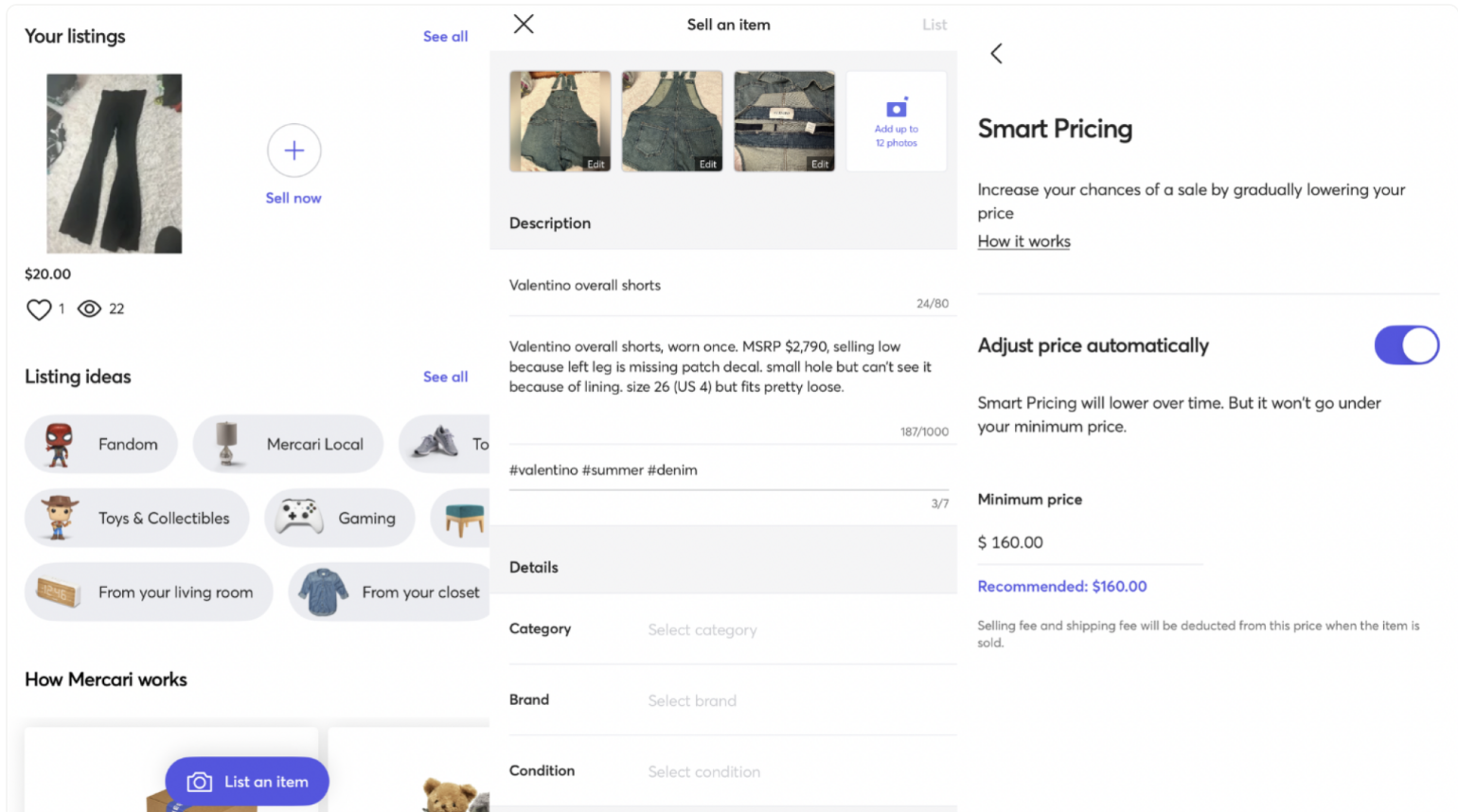
There is one downside: While all apps take a little cut of your profit in the form of seller's fees, not every app charges buyer's fees, however, which Mercari does as of January 2025: Buyers pay a "Buyer Protection Fee" of 3.6% on Mercari, and that fee is displayed as part of the final price in the item checkout section. Think of it like when you order food off Uber Eats, but only see the true cost, with fees, when you get to the very end.
As a seller, you may consider adjusting your pricing strategy downward to stay competitive amid these escalating costs. It’s important to factor in additional expenses such as selling fees when planning your sales. On Mercari, they take a 10% commission from your profits. Additionally, choosing to provide free shipping will likely add approximately $9 to each transaction cost. The silver lining here is that you can use your account balance within the app itself—a feature I personally appreciate greatly. Check out my detailed Mercari review here. .
Honorable mention: Rent out your clothing on Pickle
This list focuses on resale platforms; however, I've also had great success with Pickle, which is an app that enables me to rent out my accessories and clothes instead of selling them. I've only been using it for two months and few bags in my closet have already been rented multiple times. Theoretically, they can keep generating me money over and over again and I can continue using them myself; however, both statements aren’t accurate once you make a straightforward sale.
You have three options when renting items via Pickle: meet up personally with the borrower to exchange the item directly; opt for a $3 delivery service where couriers handle transportation using platforms such as Uber Eats or DoorDash; or send the item anywhere within the country. Personal meetings typically function best in major metropolitan regions, yet thanks to the shipping feature and integration with these trusted applications, Pickle remains highly effective even in more remote locations. In a recent discussion, one of Pickle’s co-founders mentioned plans to expand the types of items available on the platform shortly. This means you might soon be able to lease things like musical instruments, photography gear, or anything else taking up space at home.
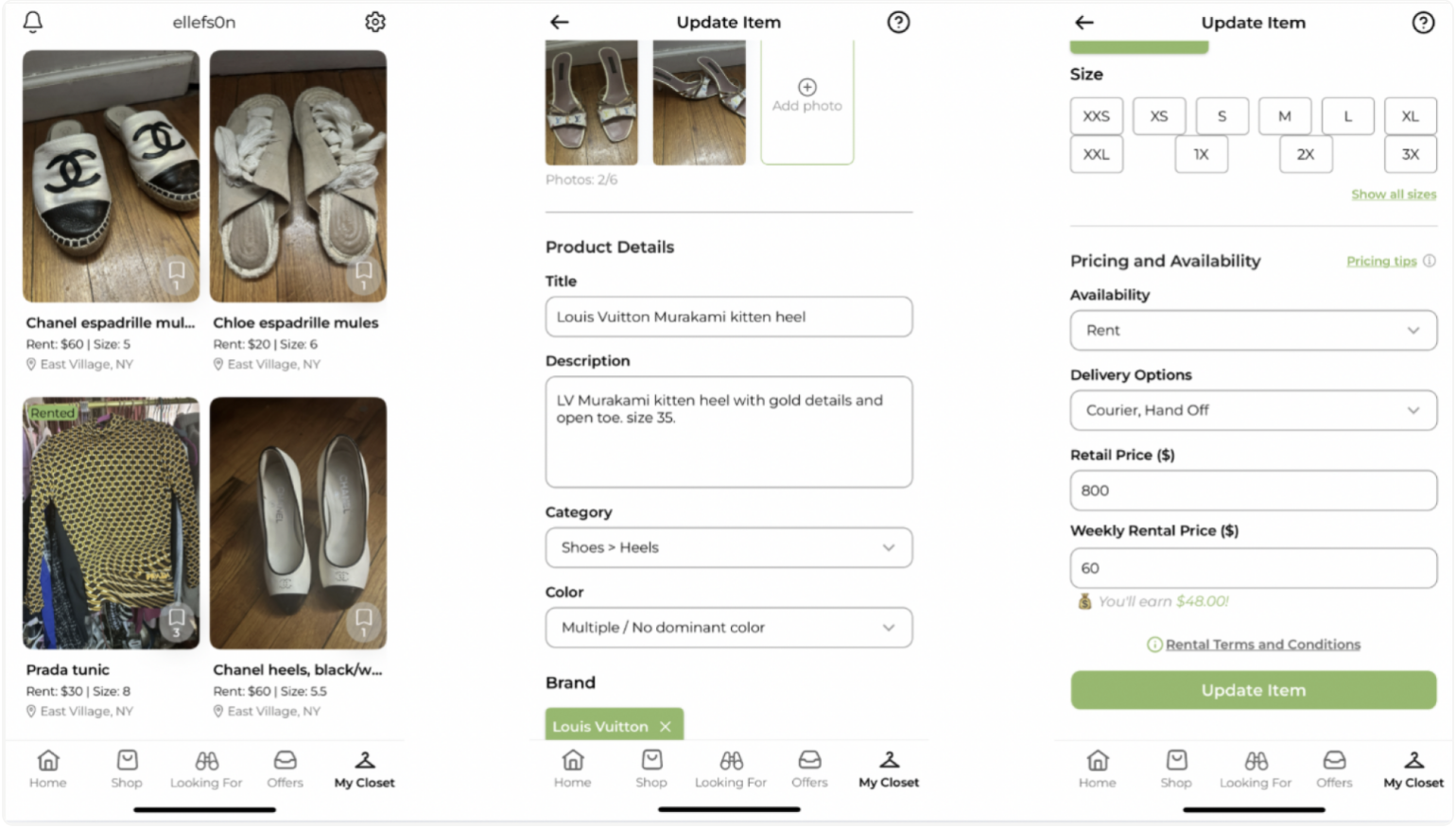
I have loved being able to put my goods to work and a few of my handbags and shoes are close to paying themselves off, so to speak. Like other apps, Pickle allows potential renters to send you an offer, which you can accept or decline, and it takes a 20% fee off your profit, but again, you get your stuff back and can rent it out again indefinitely. If you're worried about sending your possessions out, take heart knowing Pickle has a robust customer service team and care policy. If someone damages or fails to return your item, the Pickle team works with you to get you the value of the goods. That's a rarity, though, because the app has a strong community feel to it. Not only have my things always been returned in perfect condition, but they usually come with thank-you notes and, notably, one renter even sent me a thank-you gift .
Pickle is really helpful if you're starting to declutter because it is comparable to a purgatory box , or a space you put something if you're not quite sure you're ready to get rid of it. You can experience what life is like without immediate access to that item and you may even find you didn't miss it. In that case, list it on one of the apps above. Notably, Pickle also allows you to sell your stuff. All you have to do is indicate an item is for sale in its rental listing. Read my full Pickle review here .
If you liked this tale, make sure to follow Romero.my.id on MSN.
0 Response to "My Top 6 Apps for Flipping Used Clothes and Home Goods"
Post a Comment